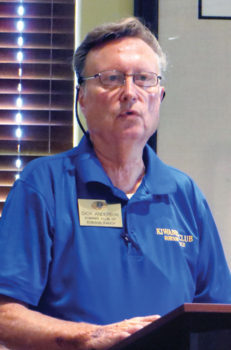
Dick Anderson, Ham radio operator, prepared for the next emergency.
Vicki Baker
In times of crisis and natural disasters when an emergency without communications can quickly become catastrophic, amateur radio operators (Hams) are ready to step in and connect people and communities. More than 750,000 Hams operate in the U.S. with 24 residing at Robson Ranch. One of those is WYIBH operator Dick Anderson, an amateur radio operator since 1954, who recounted his experience at the Kiwanis Club’s June 17 meeting.
Even in these high tech times, Ham radio is still the only failsafe communications channel in the world. The birth of amateur radio starts with the invention of the radio. Many pioneers contributed to the invention, but it was Ernst Alexanderson, a General Electric engineer, who built the first true radio making voice radio broadcasts practical. The first broadcast took place on Christmas Eve, 1906 and was a Christmas story from the Bible with a violin in the background playing Silent Night.
This was a time when everybody and anybody could occupy any wavelength they wanted. Then with the sinking of the Titanic in April 1912, new international radio laws restricted frequencies and operating procedures. Governments stepped in to regulate technical and operational characteristics of transmissions and issued individual station licenses with an identifying call sign. Professional and amateur operators alike became licensed.
The commercial radio operators called the amateurs “ham operators,” a derogatory term meaning “incompetent,” like a ham actor. But they were anything but incompetent. Today Hams help out federal, state, county and local government agencies and organizations in natural disasters and emergencies by assisting the USGS, NOAA and NWS by reporting during hurricanes, tornadoes, forest fires, earthquakes and floods. Hams also connect fire departments, police, hospital, EMS and search and rescue when regular links of communications are down.
The term “amateur” is used to specify those interested in radio solely for personal use and without any financial payment. To start his adventure into Ham radio, Dick obtained a license from the FCC as only licensed amateurs can operate a station. He completed varying levels of licensing and with each step acquired more privileges and frequencies. Once licensed, Dick set up his “station” by installing a transceiver, power supply, antenna, coax, amps and computer.
Ham radio is growing at a rate of 10% a year. It is getting more and more in-sync with new technologies and computers such as GPS. But unlike these high tech communication channels, Hams can still operate when wire lines, cell phones, internet and other conventional means fail.
Hams are prepared and ready to go when the next emergency strikes. They are our ears and voice, keeping us informed and connected to the world around us. Another way to stay connected to your community is with the Kiwanis Club Robson Ranch every first and third Friday at 8:30 a.m. in the Clubhouse. For more information contact Barbara Leurig at barbara@leurig.com.
